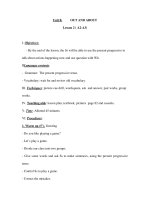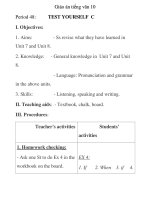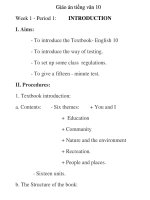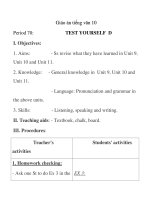Giáo án Tiếng Anh lớp 10: Unit10 : Life on other planets Lesson 2 : Reading ppt
Bạn đang xem bản rút gọn của tài liệu. Xem và tải ngay bản đầy đủ của tài liệu tại đây (71.8 KB, 5 trang )
Unit10 : Life on other planets
Lesson 2 : Speaking + Language Focus1,3,4
A. Aims:
By the end of the lesson, students will be able to talk to one another about what
they think ther may be on Mars, on the moon and on other planets; and practice using
the second conditional sentence.
*Teaching aids:
Pictures, poster
B. Content:
I. Pre
speaking:
1. Warm
up: Brainstorming
Pluto(S. Diờm Vương) Earth
Venus (S.Kim)
Mars (S.Hoả)
Neptune(S. Hải Vương) Jupiter
(S.Mộc)
Uranus Saturn (S.Thổ)
(sao Thiờn Vương) Mercury (sao Thuỷ)
Which planet is the nearest to the sun? (Mars)
Which is the biggest?
Have you ever been to Mars?
Solar system
Which is the hottest?
Do you know anything about Mars?
In this lesson we will discover Mars and guess what there’s on Mars using
May/might
2. Pre–teach:
gemstone (n) : đá quí (relia/exam) (Rubi is gemstone)
creature (n) : sinh vật (translation/example)
microorganism : vi sinh vật (translation)
trace (n) : dấu vết (sit/visual)
mineral (n) : khoáng sản, khoáng chất(example)
precious (a) : qúi, quí giá (synonym) = valuable
sparkling (a) : lấp lánh (situation/visual)
*Checking: R.O.R
3.Matching: (P.85)
- Set the scene : A space tourist traveled to Mars, he saw many things there and noted
them down. These are drawing of things. Try to guess and match the drawings with
their names in the box.
- Hang the pictures (p.85) on the board,Ss match.
- Call Ss to call out their guessing by asking :
Eg: What is this? -> It / This may/ might be water.
What are these ? -> They may/might be minerals on Mars.
*Key : a. mineral
b.water
c. mountains
d. plants
e. little creature
f. gemstone
g. gas
*Modal sentences : It may/might be water
Form : S + may/might + V (bare)
Meaning : Có thể là …
Use : To talk about present or future possibility
Concept check : Are you sure that this is water? – No
Is “might” used to say something that you are not sure of? – Yes
Does “bare inf” come after “may/might”?
Note : “Might” is normally a little less sure than “may”
II. While–speaking:
1.Making up similar dialogues about the drawings (Pairwork)
*Example:
S1: What do these drawing say?
S2: There may be mountains on Mars
S1: And what about the red signs on the left corner?
S2: Well, there might be gas on Mars.
2. Talking about what you think there might be on Mars, on the Moon and other
planets (pairwork)
3. Picture cue drill2: (Pictures drawn by the teacher)
Eg: T: What’s this?
Ss: It may be acar/a cup/…
*Steps:
T. ticks 5 pictures on the board
T gives students 5 minutes to guess that the pictures are
T lets students practice talking in pair
4. Drawing and practicing talking: (pairwork and then whole class)
Each student draws one picture and asks the question “What’s this?” for the
partner to answer
T chooses some pictures to tick on the board for students to predict, using “It may
be…/ it might be…”
III. Post
speaking:
- Show Student a picture of a alien : Who is this?
What would you do if you saw an alien?
-> If I saw an alien, I would say “hello”.
Form : If + S + V(past)…… , S + would/could + V(bare)….
Be-> were
Use : Unreal condition in the present/ future (tình huống không thể xảy ra ở
htại/ tương lai)
Practice : (LF3, p.90,91) Use pictures and given words to make conditional sentence
type II
*Key:
a. If Ba were rich, he would travel around the world.
b. If Mr Loc had a car, he would drive to work.
c. If Lan live in HCMCity, she would visit Saigon Water Park.
d. Nam would arrive school on time if he had an alarm clock.
e. If Hoa live in Hue, she could see her parents everyday.
f. If Nga owned the piano, she would play well.
g. Tuan would get better grades if he studied harder.
h. Na would buy a new computer if she had enough money.
IV. Homework:
Make up one similar dialogue about the drawings (P85), using the cues in section
a (P.85)
Do LF 1, 2,3,4. + Ex. 1,2,3 (workbook)
Prepare “Listen” p.86
V.Teacher’s self-evaluation:









